旅游英语教案
- 格式:doc
- 大小:154.50 KB
- 文档页数:17
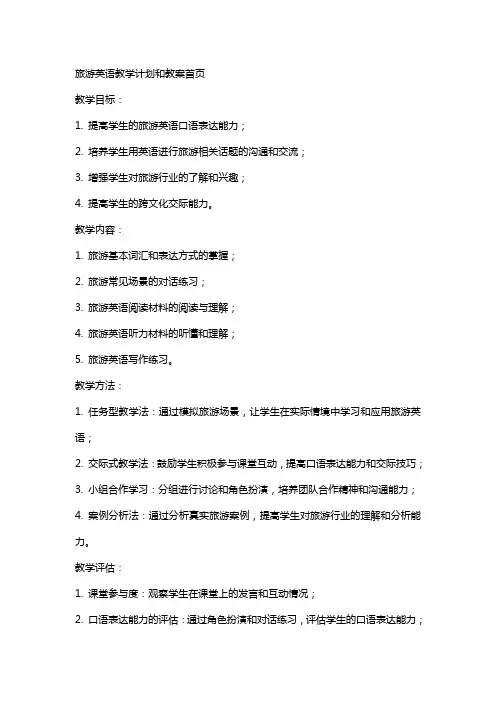
旅游英语教学计划和教案首页教学目标:1. 提高学生的旅游英语口语表达能力;2. 培养学生用英语进行旅游相关话题的沟通和交流;3. 增强学生对旅游行业的了解和兴趣;4. 提高学生的跨文化交际能力。
教学内容:1. 旅游基本词汇和表达方式的掌握;2. 旅游常见场景的对话练习;3. 旅游英语阅读材料的阅读与理解;4. 旅游英语听力材料的听懂和理解;5. 旅游英语写作练习。
教学方法:1. 任务型教学法:通过模拟旅游场景,让学生在实际情境中学习和应用旅游英语;2. 交际式教学法:鼓励学生积极参与课堂互动,提高口语表达能力和交际技巧;3. 小组合作学习:分组进行讨论和角色扮演,培养团队合作精神和沟通能力;4. 案例分析法:通过分析真实旅游案例,提高学生对旅游行业的理解和分析能力。
教学评估:1. 课堂参与度:观察学生在课堂上的发言和互动情况;2. 口语表达能力的评估:通过角色扮演和对话练习,评估学生的口语表达能力;3. 阅读理解能力的评估:通过旅游英语阅读材料,评估学生的阅读理解能力;4. 听力理解能力的评估:通过旅游英语听力材料,评估学生的听力理解能力;5. 写作能力的评估:通过旅游英语写作练习,评估学生的写作能力。
教学计划:第一周:旅游基本词汇和表达方式的掌握;第二周:旅游常见场景的对话练习;第三周:旅游英语阅读材料的阅读与理解;第四周:旅游英语听力材料的听懂和理解;第五周:旅游英语写作练习。
教学资源:1. 旅游英语教材;2. 旅游相关图片和视频资料;3. 旅游英语阅读材料;4. 旅游英语听力材料;5. 旅游英语写作练习素材。
教学环境:1. 教室环境舒适,设施齐全;2. 多媒体教学设备;3. 网络资源可随时获取。
教学重点和难点:1. 旅游英语口语表达的准确性和流畅性;2. 旅游英语阅读材料的理解和分析;3. 旅游英语听力材料的听懂和理解;4. 旅游英语写作的逻辑性和表达能力。
教学进度安排:1. 第一周:旅游基本词汇和表达方式的讲解与练习;2. 第二周:旅游常见场景的对话讲解与角色扮演练习;3. 第三周:旅游英语阅读材料的阅读与理解讲解;4. 第四周:旅游英语听力材料的听懂和理解讲解;5. 第五周:旅游英语写作练习讲解与评估。
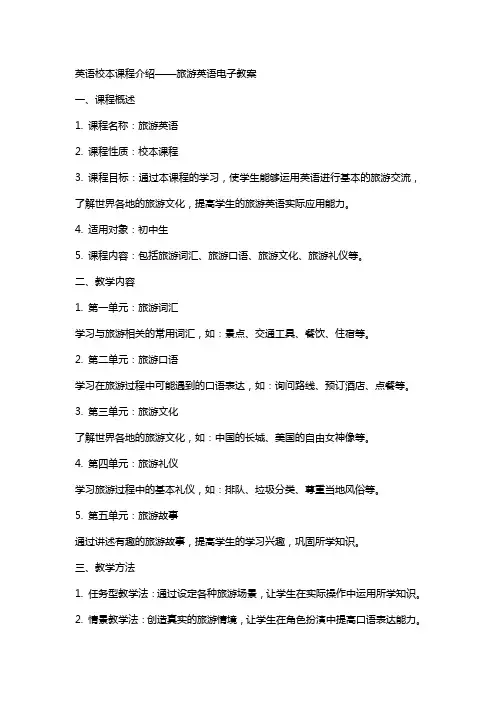
英语校本课程介绍——旅游英语电子教案一、课程概述1. 课程名称:旅游英语2. 课程性质:校本课程3. 课程目标:通过本课程的学习,使学生能够运用英语进行基本的旅游交流,了解世界各地的旅游文化,提高学生的旅游英语实际应用能力。
4. 适用对象:初中生5. 课程内容:包括旅游词汇、旅游口语、旅游文化、旅游礼仪等。
二、教学内容1. 第一单元:旅游词汇学习与旅游相关的常用词汇,如:景点、交通工具、餐饮、住宿等。
2. 第二单元:旅游口语学习在旅游过程中可能遇到的口语表达,如:询问路线、预订酒店、点餐等。
3. 第三单元:旅游文化了解世界各地的旅游文化,如:中国的长城、美国的自由女神像等。
4. 第四单元:旅游礼仪学习旅游过程中的基本礼仪,如:排队、垃圾分类、尊重当地风俗等。
5. 第五单元:旅游故事通过讲述有趣的旅游故事,提高学生的学习兴趣,巩固所学知识。
三、教学方法1. 任务型教学法:通过设定各种旅游场景,让学生在实际操作中运用所学知识。
2. 情景教学法:创造真实的旅游情境,让学生在角色扮演中提高口语表达能力。
3. 小组合作学习:鼓励学生相互讨论、分享,培养团队协作能力。
4. 信息技术辅助教学:利用多媒体、网络等资源,丰富教学手段,提高学生的学习兴趣。
四、教学评价1. 平时成绩:包括课堂参与度、作业完成情况等。
2. 期中考试:测试学生的旅游英语水平,了解学习情况。
3. 期末作品:要求学生设计一份旅游计划,包括行程、住宿、餐饮等,展示所学成果。
五、教学资源1. 教材:选用适合初中生的旅游英语教材。
2. 多媒体课件:制作与教学内容相关的多媒体课件,提高学生的学习兴趣。
3. 网络资源:利用旅游英语相关网站、APP等,提供丰富的学习资源。
4. 实物道具:准备一些旅游相关的实物道具,如地图、门票等,增强学生的直观感受。
5. 旅游实地考察:组织学生进行旅游实地考察,提高学生的实践能力。
六、教学安排1. 课时:每学期共计30课时,每周1课时。
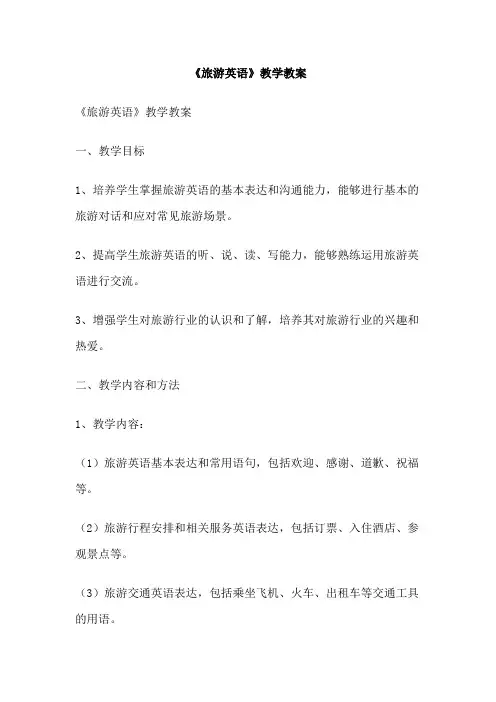
《旅游英语》教学教案《旅游英语》教学教案一、教学目标1、培养学生掌握旅游英语的基本表达和沟通能力,能够进行基本的旅游对话和应对常见旅游场景。
2、提高学生旅游英语的听、说、读、写能力,能够熟练运用旅游英语进行交流。
3、增强学生对旅游行业的认识和了解,培养其对旅游行业的兴趣和热爱。
二、教学内容和方法1、教学内容:(1)旅游英语基本表达和常用语句,包括欢迎、感谢、道歉、祝福等。
(2)旅游行程安排和相关服务英语表达,包括订票、入住酒店、参观景点等。
(3)旅游交通英语表达,包括乘坐飞机、火车、出租车等交通工具的用语。
(4)旅游餐饮英语表达,包括点菜、结账、感谢服务等。
2、教学方法:(1)课堂讲解:通过课堂讲解和示范,让学生了解和掌握旅游英语的基本表达和常用语句。
(2)情景模拟:通过情景模拟,让学生了解和掌握旅游英语在不同场景下的应用,提高学生的实际运用能力。
(3)课堂讨论:通过课堂讨论,让学生思考和探讨旅游英语在实际运用中的问题和难点,加深学生对旅游英语的理解和掌握。
(4)课后作业:通过课后作业,让学生巩固和深化对旅游英语的学习和理解。
三、教学步骤和时间安排1、导入新课(5分钟):介绍旅游英语的概念和重要性,激发学生的学习兴趣和热情。
2、讲解新课(30分钟):通过示范和讲解,让学生了解和掌握旅游英语的基本表达和常用语句。
3、情景模拟(15分钟):通过情景模拟,让学生了解和掌握旅游英语在不同场景下的应用。
4、课堂讨论(15分钟):通过课堂讨论,让学生思考和探讨旅游英语在实际运用中的问题和难点。
5、课后作业(15分钟):通过课后作业,让学生巩固和深化对旅游英语的学习和理解。
四、教学评价和反思1、课堂表现:观察学生的课堂表现,包括参与度、专注度等,了解学生对旅游英语的学习情况和问题。
2、作业评价:批改学生的课后作业,了解学生对旅游英语的学习掌握情况,并及时进行反馈和指导。
3、期末测试:进行期末测试,检测学生对旅游英语的掌握和应用能力。
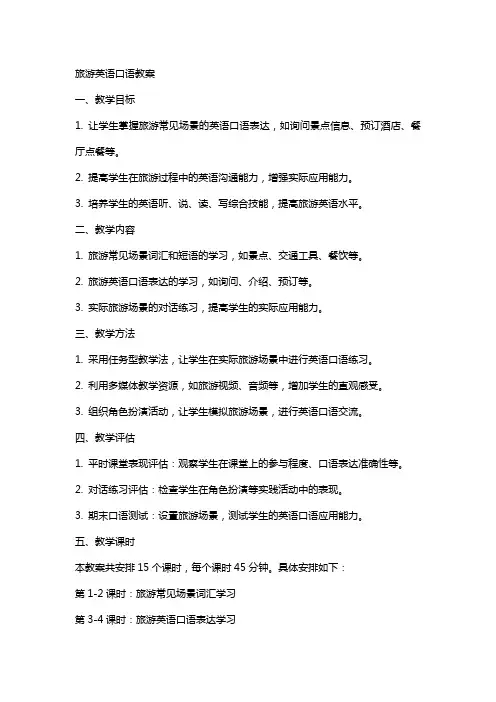
旅游英语口语教案一、教学目标1. 让学生掌握旅游常见场景的英语口语表达,如询问景点信息、预订酒店、餐厅点餐等。
2. 提高学生在旅游过程中的英语沟通能力,增强实际应用能力。
3. 培养学生的英语听、说、读、写综合技能,提高旅游英语水平。
二、教学内容1. 旅游常见场景词汇和短语的学习,如景点、交通工具、餐饮等。
2. 旅游英语口语表达的学习,如询问、介绍、预订等。
3. 实际旅游场景的对话练习,提高学生的实际应用能力。
三、教学方法1. 采用任务型教学法,让学生在实际旅游场景中进行英语口语练习。
2. 利用多媒体教学资源,如旅游视频、音频等,增加学生的直观感受。
3. 组织角色扮演活动,让学生模拟旅游场景,进行英语口语交流。
四、教学评估1. 平时课堂表现评估:观察学生在课堂上的参与程度、口语表达准确性等。
2. 对话练习评估:检查学生在角色扮演等实践活动中的表现。
3. 期末口语测试:设置旅游场景,测试学生的英语口语应用能力。
五、教学课时本教案共安排15个课时,每个课时45分钟。
具体安排如下:第1-2课时:旅游常见场景词汇学习第3-4课时:旅游英语口语表达学习第5-6课时:询问景点信息的对话练习第7-8课时:预订酒店的对话练习第9-10课时:餐厅点餐的对话练习第11-12课时:旅游过程中的常用表达学习第13-14课时:实际旅游场景的综合练习第15课时:期末口语测试六、教学资源1. 旅游英语口语教材或教学大纲。
2. 旅游相关图片、地图、视频等教学辅助材料。
3. 录音机或多媒体播放设备。
4. 旅游场景模拟道具或卡片。
七、教学步骤1. 引入:向学生介绍旅游英语口语的重要性和实用性。
2. 讲解:教授旅游常见场景词汇和短语,解释相关语法规则。
3. 示范:通过示范对话,展示旅游英语口语的表达方式。
4. 练习:组织学生进行口语练习,鼓励他们积极参与。
5. 互动:进行角色扮演活动,让学生在实际旅游场景中应用所学知识。
八、教学建议1. 鼓励学生在课堂上积极发言,提高他们的自信心和勇气。
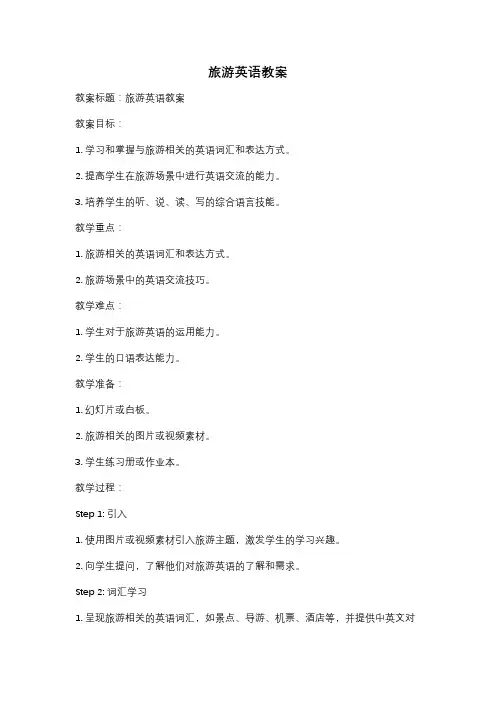
旅游英语教案教案标题:旅游英语教案教案目标:1. 学习和掌握与旅游相关的英语词汇和表达方式。
2. 提高学生在旅游场景中进行英语交流的能力。
3. 培养学生的听、说、读、写的综合语言技能。
教学重点:1. 旅游相关的英语词汇和表达方式。
2. 旅游场景中的英语交流技巧。
教学难点:1. 学生对于旅游英语的运用能力。
2. 学生的口语表达能力。
教学准备:1. 幻灯片或白板。
2. 旅游相关的图片或视频素材。
3. 学生练习册或作业本。
教学过程:Step 1: 引入1. 使用图片或视频素材引入旅游主题,激发学生的学习兴趣。
2. 向学生提问,了解他们对旅游英语的了解和需求。
Step 2: 词汇学习1. 呈现旅游相关的英语词汇,如景点、导游、机票、酒店等,并提供中英文对照和发音。
2. 进行词汇的拓展和巩固练习,如词汇匹配、填空等。
Step 3: 口语表达1. 呈现旅游场景中常用的英语表达方式,如问路、订酒店、点菜等。
2. 通过角色扮演或小组讨论的形式,让学生实践这些口语表达。
Step 4: 听力训练1. 播放旅游场景的听力材料,如导游的讲解或旅客的对话。
2. 提供听力问题,让学生通过听力理解并回答问题。
Step 5: 阅读与写作1. 分发旅游相关的阅读材料,如旅游指南或游记。
2. 学生阅读材料并回答相关问题,或写一篇关于自己旅游经历的文章。
Step 6: 练习与巩固1. 分发练习册或作业本,让学生进行旅游英语的练习和巩固。
2. 教师巡回指导,解答学生的问题。
Step 7: 总结与反馈1. 对本节课所学内容进行总结,并强调重点和难点。
2. 鼓励学生提出问题和反馈意见,以便调整教学方法和内容。
教学延伸:1. 鼓励学生自主学习和实践旅游英语,如与外国友人交流、观看英语旅游节目等。
2. 组织学生进行旅游英语角活动,提供更多的实践机会。
教学评估:1. 课堂参与度:观察学生在课堂中的积极参与程度。
2. 口语表达能力:评估学生在口语表达练习中的流利程度和准确性。
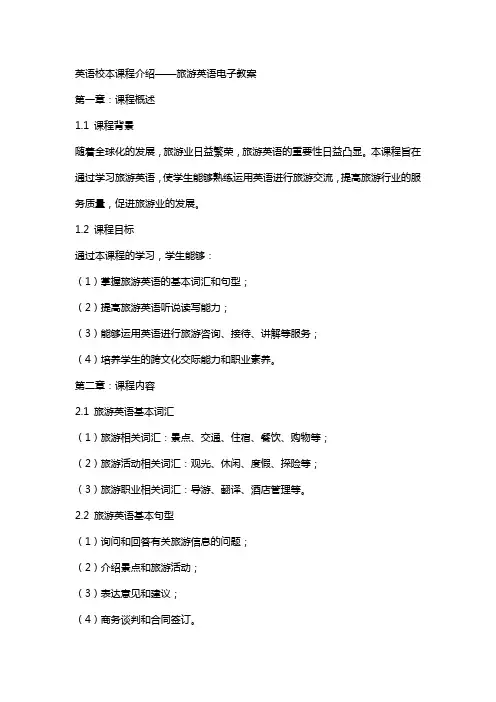
英语校本课程介绍——旅游英语电子教案第一章:课程概述1.1 课程背景随着全球化的发展,旅游业日益繁荣,旅游英语的重要性日益凸显。
本课程旨在通过学习旅游英语,使学生能够熟练运用英语进行旅游交流,提高旅游行业的服务质量,促进旅游业的发展。
1.2 课程目标通过本课程的学习,学生能够:(1)掌握旅游英语的基本词汇和句型;(2)提高旅游英语听说读写能力;(3)能够运用英语进行旅游咨询、接待、讲解等服务;(4)培养学生的跨文化交际能力和职业素养。
第二章:课程内容2.1 旅游英语基本词汇(1)旅游相关词汇:景点、交通、住宿、餐饮、购物等;(2)旅游活动相关词汇:观光、休闲、度假、探险等;(3)旅游职业相关词汇:导游、翻译、酒店管理等。
2.2 旅游英语基本句型(1)询问和回答有关旅游信息的问题;(2)介绍景点和旅游活动;(3)表达意见和建议;(4)商务谈判和合同签订。
2.3 旅游英语听说读写技能训练(1)听力训练:听懂旅游相关的对话和讲座;(2)口语训练:能够进行旅游咨询、接待、讲解等实际操作;(3)阅读训练:阅读旅游相关的文章,获取有效信息;第三章:教学方法3.1 任务驱动法:通过完成实际工作任务,提高学生的旅游英语应用能力;3.2 情景教学法:创设旅游情境,培养学生的实际操作能力;3.3 交际法:鼓励学生积极参与旅游英语交流,提高跨文化交际能力;3.4 小组合作学习:学生分组进行讨论和实践活动,提高团队协作能力。
第四章:课程评价4.1 过程性评价:关注学生在课堂活动中的表现,提高学生的参与度和积极性;4.2 终结性评价:通过期末考试,检验学生的旅游英语综合应用能力;4.3 自我评价:鼓励学生进行自我反思,提高自主学习能力。
第五章:教学资源5.1 教材:选用适合旅游英语教学的教材,如《旅游英语》、《实用旅游英语》等;5.2 网络资源:利用互联网查找旅游英语相关资料,如旅游网站、英文资讯等;5.3 音像资料:观看旅游英语相关的视频和音频资料,提高听说能力;5.4 实地考察:组织学生进行实地考察,增强对旅游英语的实际应用能力。
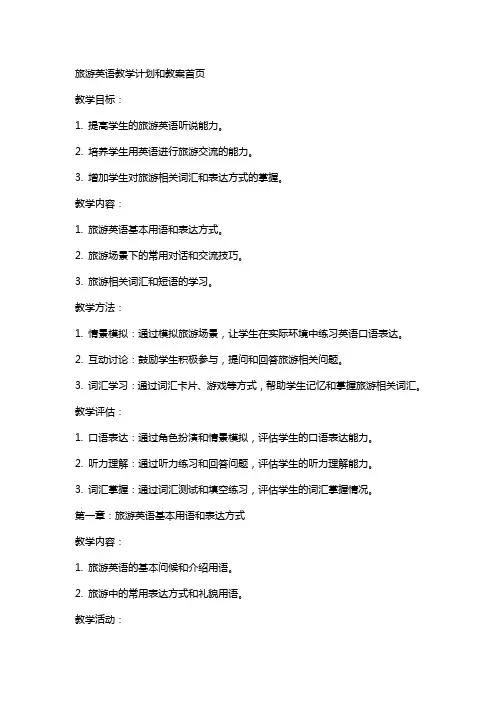
旅游英语教学计划和教案首页教学目标:1. 提高学生的旅游英语听说能力。
2. 培养学生用英语进行旅游交流的能力。
3. 增加学生对旅游相关词汇和表达方式的掌握。
教学内容:1. 旅游英语基本用语和表达方式。
2. 旅游场景下的常用对话和交流技巧。
3. 旅游相关词汇和短语的学习。
教学方法:1. 情景模拟:通过模拟旅游场景,让学生在实际环境中练习英语口语表达。
2. 互动讨论:鼓励学生积极参与,提问和回答旅游相关问题。
3. 词汇学习:通过词汇卡片、游戏等方式,帮助学生记忆和掌握旅游相关词汇。
教学评估:1. 口语表达:通过角色扮演和情景模拟,评估学生的口语表达能力。
2. 听力理解:通过听力练习和回答问题,评估学生的听力理解能力。
3. 词汇掌握:通过词汇测试和填空练习,评估学生的词汇掌握情况。
第一章:旅游英语基本用语和表达方式教学内容:1. 旅游英语的基本问候和介绍用语。
2. 旅游中的常用表达方式和礼貌用语。
教学活动:1. 情景模拟:模拟机场接机和酒店入住的场景,练习基本用语。
2. 角色扮演:学生分组进行角色扮演,模拟旅游中的交流场景。
作业:1. 复习并练习旅游英语的基本用语。
2. 准备旅游场景下的对话练习。
第二章:旅游场景下的常用对话和交流技巧教学内容:1. 旅游中的常用对话和表达方式。
2. 交流技巧的培养和实践。
教学活动:1. 情景模拟:模拟餐厅点餐和购物场景,练习常用对话。
2. 小组讨论:学生分组讨论旅游中的交流技巧。
作业:1. 复习并练习旅游场景下的常用对话。
2. 思考和总结旅游中的交流技巧。
第三章:旅游相关词汇和短语的学习教学内容:1. 旅游相关词汇的学习和记忆。
2. 旅游短语的运用和练习。
教学活动:1. 词汇卡片:学生制作词汇卡片,互相学习和复习。
2. 词汇游戏:通过词汇游戏,帮助学生记忆和掌握旅游相关词汇。
作业:1. 复习并掌握旅游相关词汇。
2. 练习使用旅游短语进行对话。
第四章:旅游英语听力和口语练习教学内容:1. 旅游英语听力和口语的练习。
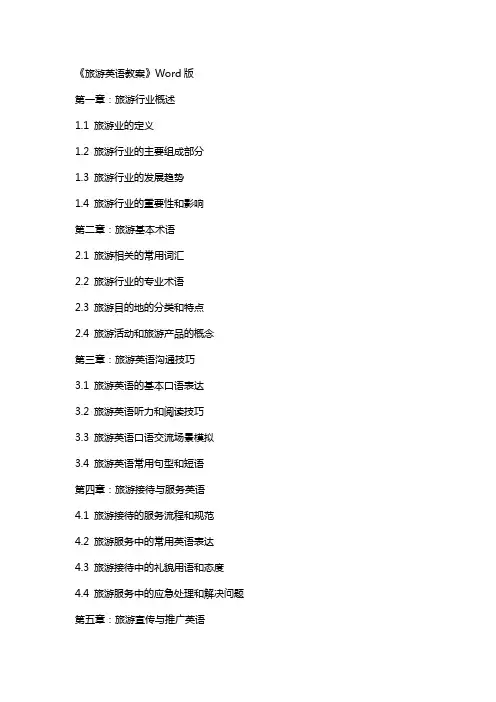
《旅游英语教案》Word版第一章:旅游行业概述1.1 旅游业的定义1.2 旅游行业的主要组成部分1.3 旅游行业的发展趋势1.4 旅游行业的重要性和影响第二章:旅游基本术语2.1 旅游相关的常用词汇2.2 旅游行业的专业术语2.3 旅游目的地的分类和特点2.4 旅游活动和旅游产品的概念第三章:旅游英语沟通技巧3.1 旅游英语的基本口语表达3.2 旅游英语听力和阅读技巧3.3 旅游英语口语交流场景模拟3.4 旅游英语常用句型和短语第四章:旅游接待与服务英语4.1 旅游接待的服务流程和规范4.2 旅游服务中的常用英语表达4.3 旅游接待中的礼貌用语和态度4.4 旅游服务中的应急处理和解决问题第五章:旅游宣传与推广英语5.1 旅游宣传材料的基本要素5.2 旅游宣传英语的写作技巧5.3 旅游推广中常用的英语表达和句型5.4 旅游宣传英语的实际应用案例第六章:旅游翻译技巧6.1 旅游翻译的重要性6.2 旅游翻译的基本原则6.3 旅游翻译技巧与策略6.4 旅游翻译实践案例分析第七章:导游英语7.1 导游英语的基本要求7.2 导游英语口语表达技巧7.3 导游英语讲解实例与分析7.4 导游英语应急处理与沟通策略第八章:旅游商务英语8.1 旅游商务英语的应用场景8.2 旅游商务英语的基本词汇与表达8.3 旅游商务英语的写作与口语技巧8.4 旅游商务英语的实际交流案例第九章:旅游市场营销英语9.1 旅游市场营销的基本概念9.2 旅游市场营销英语的常用术语9.3 旅游市场营销材料的编写技巧9.4 旅游市场营销英语的实际应用案例第十章:旅游英语案例分析与实践10.1 旅游英语实际案例分析10.2 旅游英语实践操作演练10.3 旅游英语口语与听力综合训练10.4 旅游英语综合能力测试与评估重点和难点解析一、旅游行业概述补充说明:通过具体数据和案例分析,深入探讨旅游业的发展趋势,以及旅游业对经济、文化、环境等方面的影响,使学生更全面地理解旅游行业的重要性。
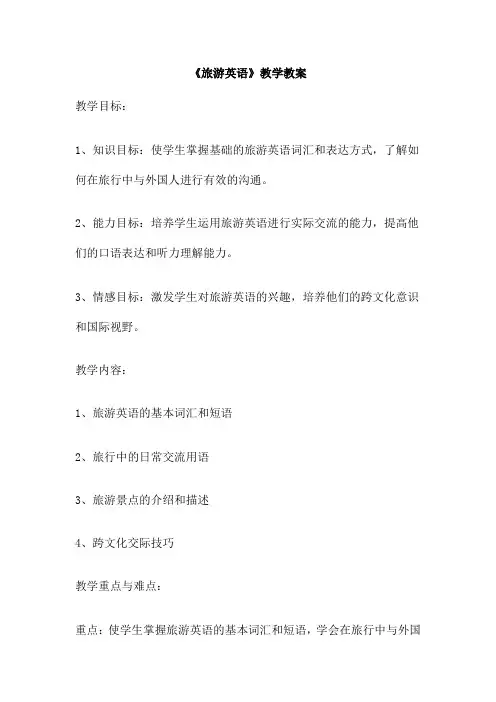
《旅游英语》教学教案教学目标:1、知识目标:使学生掌握基础的旅游英语词汇和表达方式,了解如何在旅行中与外国人进行有效的沟通。
2、能力目标:培养学生运用旅游英语进行实际交流的能力,提高他们的口语表达和听力理解能力。
3、情感目标:激发学生对旅游英语的兴趣,培养他们的跨文化意识和国际视野。
教学内容:1、旅游英语的基本词汇和短语2、旅行中的日常交流用语3、旅游景点的介绍和描述4、跨文化交际技巧教学重点与难点:重点:使学生掌握旅游英语的基本词汇和短语,学会在旅行中与外国人进行日常交流。
难点:如何准确、流利地使用旅游英语进行交流,以及跨文化交际技巧的应用。
教具和多媒体资源:1、投影仪和PPT2、旅游英语视频材料3、旅游英语词汇卡片4、模拟场景道具教学方法:1、激活学生的前知:回顾已学的英语词汇和短语,与旅游英语相关的内容进行对比和。
2、教学策略:通过讲解、示范、小组讨论和角色扮演等方式,使学生掌握旅游英语的表达方式。
3、学生活动:组织学生进行模拟旅行对话,提高他们的口语表达和听力理解能力。
教学过程:1、导入(5分钟):通过提问的方式,了解学生对旅游英语的兴趣和前期知识储备。
2、讲授新课(30分钟):讲解旅游英语的基本词汇和短语,展示并让学生模仿实用的旅行对话。
3、巩固练习(15分钟):学生分组进行角色扮演,模拟旅行中的各种场景进行对话。
教师进行巡视,给予必要的指导和反馈。
4、归纳小结(10分钟):总结本节课学习的重点内容,回顾旅行英语的关键表达方式,鼓励学生进行口头总结。
评价与反馈:1、设计评价策略:组织学生进行小组角色扮演活动,观察他们的实际交流能力和口语表达水平。
结合学生的自我评价和互相评价,对学生的学习效果进行综合评估。
2、为学生提供反馈:在角色扮演活动结束后,对学生的表现给予及时的反馈,指出他们在旅游英语表达中的优点和不足之处。
引导学生反思自己的学习过程和方法,以便进一步提高学习效果。
作业布置:1、复习本节课所学的旅游英语词汇和短语。
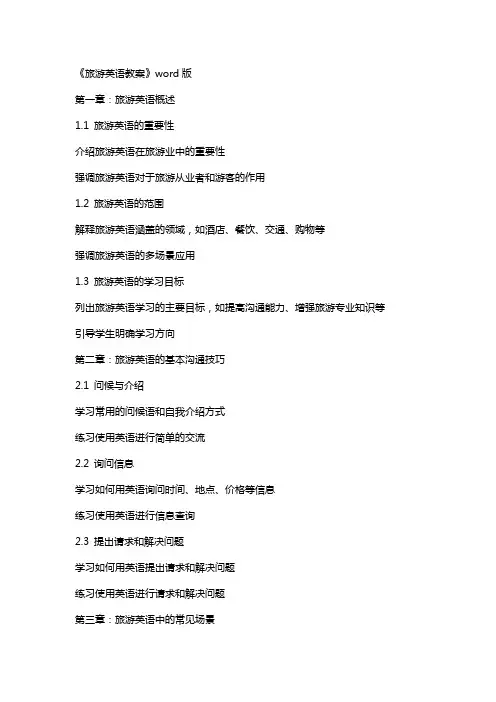
《旅游英语教案》word版第一章:旅游英语概述1.1 旅游英语的重要性介绍旅游英语在旅游业中的重要性强调旅游英语对于旅游从业者和游客的作用1.2 旅游英语的范围解释旅游英语涵盖的领域,如酒店、餐饮、交通、购物等强调旅游英语的多场景应用1.3 旅游英语的学习目标列出旅游英语学习的主要目标,如提高沟通能力、增强旅游专业知识等引导学生明确学习方向第二章:旅游英语的基本沟通技巧2.1 问候与介绍学习常用的问候语和自我介绍方式练习使用英语进行简单的交流2.2 询问信息学习如何用英语询问时间、地点、价格等信息练习使用英语进行信息查询2.3 提出请求和解决问题学习如何用英语提出请求和解决问题练习使用英语进行请求和解决问题第三章:旅游英语中的常见场景3.1 酒店入住与退房学习酒店入住和退房的相关英语表达练习使用英语进行酒店入住和退房的交流3.2 餐厅用餐学习餐厅用餐的相关英语表达练习使用英语进行点餐、用餐的交流3.3 交通出行学习交通出行的相关英语表达练习使用英语进行购票、问路等的交流第四章:旅游英语中的购物与娱乐4.1 购物学习购物的相关英语表达练习使用英语进行购物交流4.2 娱乐活动学习娱乐活动的相关英语表达练习使用英语进行娱乐活动交流4.3 旅游英语口语拓展学习一些旅游英语口语拓展表达练习使用英语进行更丰富的交流第五章:旅游英语中的文化差异与礼仪5.1 文化差异介绍不同国家的文化差异对旅游英语的影响强调理解和尊重不同文化的的重要性5.2 旅游礼仪学习旅游中的礼仪规范练习使用英语进行礼貌的交流和行为展示第六章:旅游英语中的餐饮服务6.1 餐厅用语学习在餐厅中常用的英语表达,如点餐、询问菜品、表达喜好等练习在模拟餐厅环境中进行点餐交流6.2 酒店客房服务学习酒店客房服务的相关英语表达,如订餐、叫醒服务、洗衣服务等练习使用英语进行客房服务的交流第七章:旅游英语中的交通出行7.1 飞机出行学习乘坐飞机的相关英语表达,如办理登机手续、询问航班信息、机场security 等练习使用英语进行飞机出行的交流7.2 火车旅行学习乘坐火车的相关英语表达,如购票、询问车次信息、火车站设施等练习使用英语进行火车旅行的交流第八章:旅游英语中的景点介绍8.1 自然风光学习描述自然风光的英语表达,如山脉、海滩、沙漠等练习使用英语进行自然风光的介绍8.2 人文景观学习描述人文景观的英语表达,如古迹、博物馆、城市建筑等练习使用英语进行人文景观的介绍第九章:旅游英语中的紧急情况应对9.1 疾病与意外学习在旅游过程中应对疾病和意外的基本英语表达练习使用英语进行求助和描述症状9.2 安全问题学习在旅游过程中应对安全问题的基本英语表达练习使用英语进行报警和求助第十章:旅游英语的综合应用10.1 模拟旅游场景设计一个综合性的旅游场景,如旅行社咨询、机场接机、酒店入住等让学生在模拟场景中综合运用旅游英语10.2 旅游英语口语测试设计一个旅游英语口语测试,包括常见场景的问答、角色扮演等评估学生的旅游英语口语水平和沟通能力重点和难点解析章节一:旅游英语概述难点解析:理解旅游英语在旅游业中的作用及其对旅游从业者和游客的意义。
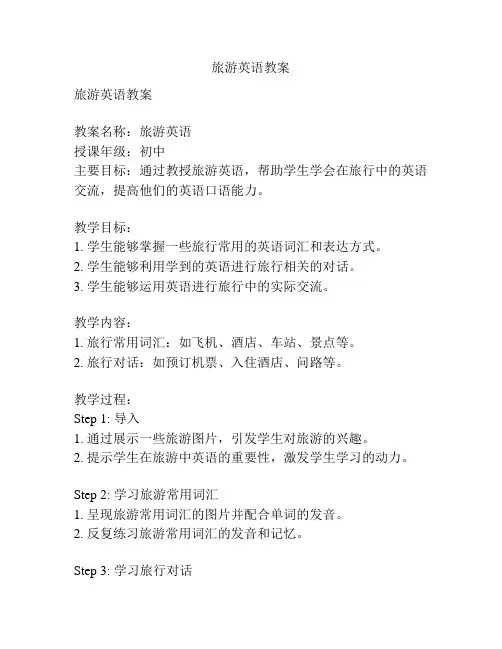
旅游英语教案旅游英语教案教案名称:旅游英语授课年级:初中主要目标:通过教授旅游英语,帮助学生学会在旅行中的英语交流,提高他们的英语口语能力。
教学目标:1. 学生能够掌握一些旅行常用的英语词汇和表达方式。
2. 学生能够利用学到的英语进行旅行相关的对话。
3. 学生能够运用英语进行旅行中的实际交流。
教学内容:1. 旅行常用词汇:如飞机、酒店、车站、景点等。
2. 旅行对话:如预订机票、入住酒店、问路等。
教学过程:Step 1: 导入1. 通过展示一些旅游图片,引发学生对旅游的兴趣。
2. 提示学生在旅游中英语的重要性,激发学生学习的动力。
Step 2: 学习旅游常用词汇1. 呈现旅游常用词汇的图片并配合单词的发音。
2. 反复练习旅游常用词汇的发音和记忆。
Step 3: 学习旅行对话1. 呈现一些旅行对话的情景,如预订机票、入住酒店、问路等,并进行解释和示范。
2. 学生跟读并模仿对话,提高他们的口语表达能力。
Step 4: 练习1. 分组练习:将学生分成小组,让他们进行旅行对话的练习。
2. 角色扮演:学生分别扮演旅客和旅游工作人员,进行实际对话练习。
Step 5: 任务1. 给学生一个旅行任务,让他们利用学到的英语在实际情境中进行交流。
2. 学生完成任务后,进行班级讨论和反馈,提供指导和纠正。
Step 6: 总结和评价1. 总结学到的旅游英语表达方式和交流技巧。
2. 对学生的学习进行评价和反馈,鼓励他们继续学习和提高。
Step 7: 拓展1. 提供一些旅游英语学习资源,如英语教材、词汇卡片、听力练习等,让学生自主学习和巩固所学知识。
2. 鼓励学生参加一些英语角、英语活动,提高他们的英语口语和交流能力。
Step 8: 结束总结本节课的收获和体会,并鼓励学生在实际旅行中尽量运用学到的英语。
教学目标:1. 学生能够掌握基本的旅游英语词汇和短语。
2. 学生能够运用所学英语进行简单的旅游对话。
3. 学生能够了解基本的旅游文化知识。
教学重点:1. 旅游英语词汇和短语的学习。
2. 旅游对话的实际运用。
教学难点:1. 旅游英语词汇的拼写和发音。
2. 旅游对话的语境理解。
教学过程:一、导入1. 教师用简单的英语提问:“Do you like traveling? Why or why not?” 引导学生思考并回答。
2. 教师简要介绍旅游英语的重要性,激发学生的学习兴趣。
二、新课导入1. 教师展示一些旅游相关的图片,如景点、交通工具、酒店等,引导学生猜测这些图片的英文单词。
2. 教师讲解并教授以下旅游英语词汇和短语:- Scenery: 风景- Transport: 交通工具- Hotel: 酒店- Restaurant: 餐厅- Museum: 博物馆- Ticket: 票- Guidebook: 旅行指南- Souvenir: 纪念品三、课堂练习1. 教师带领学生进行以下练习:- 拼写练习:学生拼写刚刚学过的旅游英语词汇。
- 发音练习:学生跟读并模仿教师的发音。
- 造句练习:学生运用所学词汇和短语进行造句。
四、情景对话1. 教师创设以下情景,引导学生进行对话:- 在机场询问航班信息。
- 在酒店预订房间。
- 在餐厅点餐。
- 在景点询问路线。
2. 教师分组进行角色扮演,让学生在实际情景中运用所学英语。
五、总结与作业1. 教师总结本节课所学内容,强调重点和难点。
2. 布置以下作业:- 复习本节课所学词汇和短语。
- 预习下一节课的内容。
教学反思:本节课通过图片、词汇、情景对话等多种形式,让学生在轻松愉快的氛围中学习旅游英语。
在今后的教学中,我将继续关注学生的学习效果,适时调整教学方法,以提高学生的英语实际运用能力。
旅游英语教案范文:一、教学目标1. 学生能够掌握基本的旅游英语词汇和短语。
2. 学生能够运用所学英语进行简单的旅游对话。
《旅游英语》教学教案一、教学目标1. 让学生掌握旅游英语的基本词汇和表达方式。
2. 提高学生在旅游场合的听说读写能力。
3. 培养学生用英语进行旅游交流的能力。
二、教学内容1. 旅游英语基本词汇:景点、交通工具、餐饮、住宿、购物等。
2. 旅游英语常用表达:询问信息、介绍景点、预订酒店、点餐等。
3. 旅游英语对话练习:模拟旅游场景,进行角色扮演。
三、教学方法1. 任务型教学法:通过完成各种旅游相关任务,让学生学会应用所学知识。
2. 情景教学法:模拟旅游实景,让学生在实际语境中学习旅游英语。
3. 交际法:鼓励学生进行旅游话题的讨论,提高口语表达能力。
四、教学步骤1. 引入:引导学生谈论旅游话题,激发学习兴趣。
2. 讲解:讲解旅游英语基本词汇和常用表达。
3. 实践:进行旅游场景的角色扮演,练习对话。
4. 任务:布置旅游相关的写作或口语作业,巩固所学知识。
五、教学评价1. 课堂参与度:观察学生在课堂上的发言和互动情况。
2. 作业完成情况:评估学生完成的旅游英语写作或口语任务。
3. 期末考试:测试学生旅游英语的综合运用能力。
六、教学资源1. 教材:《旅游英语》教材或相关旅游英语学习资料。
2. 多媒体课件:旅游景点图片、视频、音频等。
3. 角色扮演道具:地图、飞机票、酒店卡片等。
4. 在线资源:旅游英语学习网站、旅游资讯网站等。
七、教学环境1. 教室布局:座位排列便于学生互动交流。
2. 教学设备:投影仪、音响、计算机等。
3. 氛围营造:轻松愉快的旅游主题氛围,如播放旅游相关音乐。
八、教学策略1. 差异化教学:针对不同水平的学生,提供相应难度的旅游英语学习材料。
2. 激励机制:设置旅游主题的奖励,鼓励学生积极参与。
3. 合作学习:组织学生进行小组讨论,共同完成旅游英语任务。
九、教学计划1. 课时安排:每课时45分钟,共15课时。
2. 课程进度:按照教学大纲和教材安排课程内容。
3. 作业布置:每节课后布置相关旅游英语作业,巩固所学知识。
《旅游英语》教学教案第一章:旅游英语概述1.1 教学目标了解旅游英语的基本概念和重要性掌握旅游英语的基本口语表达和常用词汇1.2 教学内容旅游英语的定义和作用旅游英语的基本口语表达和常用词汇1.3 教学方法讲授法:讲解旅游英语的基本概念和重要性互动法:进行口语练习,让学生熟练掌握旅游英语表达1.4 教学步骤引入旅游英语的概念和重要性讲解旅游英语的基本口语表达和常用词汇进行口语练习,让学生熟练掌握旅游英语表达第二章:旅游信息查询与预订2.1 教学目标学会使用旅游英语查询和预订旅游信息掌握旅游英语相关的表达方式和常用词汇2.2 教学内容旅游信息的查询和预订方式旅游英语相关的表达方式和常用词汇讲授法:讲解旅游信息的查询和预订方式互动法:进行角色扮演,让学生熟练掌握旅游英语表达2.4 教学步骤引入旅游信息的查询和预订方式讲解旅游英语相关的表达方式和常用词汇进行角色扮演,让学生熟练掌握旅游英语表达第三章:机场与航空公司3.1 教学目标学会使用旅游英语与机场和航空公司人员进行沟通掌握机场和航空公司相关的表达方式和常用词汇3.2 教学内容机场和航空公司的基本流程和相关规定旅游英语相关的表达方式和常用词汇3.3 教学方法讲授法:讲解机场和航空公司的基本流程和相关规定互动法:进行情景模拟,让学生熟练掌握旅游英语表达3.4 教学步骤引入机场和航空公司的基本流程和相关规定讲解旅游英语相关的表达方式和常用词汇进行情景模拟,让学生熟练掌握旅游英语表达第四章:酒店预订与入住学会使用旅游英语预订酒店并办理入住手续掌握酒店预订和入住相关的表达方式和常用词汇4.2 教学内容酒店预订的流程和相关规定旅游英语相关的表达方式和常用词汇4.3 教学方法讲授法:讲解酒店预订的流程和相关规定互动法:进行角色扮演,让学生熟练掌握旅游英语表达4.4 教学步骤引入酒店预订的流程和相关规定讲解旅游英语相关的表达方式和常用词汇进行角色扮演,让学生熟练掌握旅游英语表达第五章:旅游活动与购物5.1 教学目标学会使用旅游英语参加旅游活动和购物掌握旅游活动和购物相关的表达方式和常用词汇5.2 教学内容旅游活动的参加方式和相关规定购物时的基本表达方式和常用词汇5.3 教学方法讲授法:讲解旅游活动的参加方式和相关规定互动法:进行情景模拟,让学生熟练掌握旅游英语表达5.4 教学步骤引入旅游活动的参加方式和相关规定讲解购物时的基本表达方式和常用词汇进行情景模拟,让学生熟练掌握旅游英语表达第六章:餐饮服务与点餐6.1 教学目标学会使用旅游英语在餐厅进行点餐和服务交流掌握餐饮服务相关的表达方式和常用词汇6.2 教学内容餐厅的基本服务流程和点餐方式旅游英语相关的表达方式和常用词汇6.3 教学方法讲授法:讲解餐厅的基本服务流程和点餐方式互动法:进行角色扮演,让学生熟练掌握旅游英语表达6.4 教学步骤引入餐厅的基本服务流程和点餐方式讲解旅游英语相关的表达方式和常用词汇进行角色扮演,让学生熟练掌握旅游英语表达第七章:交通出行与问路7.1 教学目标学会使用旅游英语进行交通出行和问路掌握交通出行和问路相关的表达方式和常用词汇7.2 教学内容各种交通工具的乘坐方式和相关规定问路时的基本表达方式和常用词汇7.3 教学方法讲授法:讲解各种交通工具的乘坐方式和相关规定互动法:进行情景模拟,让学生熟练掌握旅游英语表达7.4 教学步骤引入各种交通工具的乘坐方式和相关规定讲解问路时的基本表达方式和常用词汇进行情景模拟,让学生熟练掌握旅游英语表达第八章:紧急情况应对8.1 教学目标学会使用旅游英语应对紧急情况掌握紧急情况应对相关的表达方式和常用词汇8.2 教学内容紧急情况的分类和应对方法旅游英语相关的表达方式和常用词汇8.3 教学方法讲授法:讲解紧急情况的分类和应对方法互动法:进行情景模拟,让学生熟练掌握旅游英语表达8.4 教学步骤引入紧急情况的分类和应对方法讲解旅游英语相关的表达方式和常用词汇进行情景模拟,让学生熟练掌握旅游英语表达第九章:旅游文化习俗9.1 教学目标了解世界各地的旅游文化习俗学会使用旅游英语尊重和适应不同文化的习俗9.2 教学内容世界各地的旅游文化习俗介绍旅游英语相关的表达方式和常用词汇9.3 教学方法讲授法:讲解世界各地的旅游文化习俗互动法:进行小组讨论,让学生了解和尊重不同文化习俗9.4 教学步骤引入世界各地的旅游文化习俗介绍讲解旅游英语相关的表达方式和常用词汇进行小组讨论,让学生了解和尊重不同文化习俗第十章:旅游宣传与推荐10.1 教学目标学会使用旅游英语进行旅游宣传和推荐掌握旅游宣传和推荐相关的表达方式和常用词汇10.2 教学内容旅游宣传的方式和技巧旅游英语相关的表达方式和常用词汇10.3 教学方法讲授法:讲解旅游宣传的方式和技巧互动法:进行小组讨论,让学生熟练掌握旅游英语表达10.4 教学步骤引入旅游宣传的方式和技巧讲解旅游英语相关的表达方式和常用词汇进行小组讨论,让学生熟练掌握旅游英语表达第十一章:旅游业务交流11.1 教学目标学会使用旅游英语进行业务交流掌握旅游业务相关的表达方式和常用词汇11.2 教学内容旅游业务的交流方式和技巧旅游英语相关的表达方式和常用词汇11.3 教学方法讲授法:讲解旅游业务的交流方式和技巧互动法:进行角色扮演,让学生熟练掌握旅游英语表达11.4 教学步骤引入旅游业务的交流方式和技巧讲解旅游英语相关的表达方式和常用词汇进行角色扮演,让学生熟练掌握旅游英语表达第十二章:旅游文学与翻译12.1 教学目标了解旅游文学的基本概念和作用学会使用旅游英语进行文学翻译和表达12.2 教学内容旅游文学的基本概念和作用旅游英语相关的翻译技巧和表达方式12.3 教学方法讲授法:讲解旅游文学的基本概念和作用互动法:进行文学作品的翻译练习,让学生熟练掌握旅游英语表达12.4 教学步骤引入旅游文学的基本概念和作用讲解旅游英语相关的翻译技巧和表达方式进行文学作品的翻译练习,让学生熟练掌握旅游英语表达第十三章:旅游行程规划与报价13.1 教学目标学会使用旅游英语进行旅游行程规划与报价掌握旅游行程规划与报价相关的表达方式和常用词汇13.2 教学内容旅游行程规划的步骤和技巧旅游报价的计算和方法讲授法:讲解旅游行程规划的步骤和技巧互动法:进行实际案例分析,让学生熟练掌握旅游英语表达13.4 教学步骤引入旅游行程规划的步骤和技巧讲解旅游报价的计算和方法进行实际案例分析,让学生熟练掌握旅游英语表达第十四章:旅游项目管理14.1 教学目标学会使用旅游英语进行旅游项目管理掌握旅游项目管理相关的表达方式和常用词汇14.2 教学内容旅游项目的策划和管理流程旅游英语相关的表达方式和常用词汇14.3 教学方法讲授法:讲解旅游项目的策划和管理流程互动法:进行小组讨论,让学生熟练掌握旅游英语表达14.4 教学步骤引入旅游项目的策划和管理流程讲解旅游英语相关的表达方式和常用词汇进行小组讨论,让学生熟练掌握旅游英语表达第十五章:旅游职业道德与规范了解旅游职业道德的重要性学会使用旅游英语进行职业道德与规范的交流15.2 教学内容旅游职业道德的基本原则和规范旅游英语相关的表达方式和常用词汇15.3 教学方法讲授法:讲解旅游职业道德的基本原则和规范互动法:进行小组讨论,让学生了解和遵守职业道德与规范15.4 教学步骤引入旅游职业道德的重要性讲解旅游英语相关的表达方式和常用词汇进行小组讨论,让学生了解和遵守职业道德与规范重点和难点解析重点:1. 旅游英语的基本概念和重要性2. 旅游英语相关的表达方式和常用词汇3. 旅游信息的查询和预订方式4. 机场和航空公司的基本流程和相关规定5. 酒店预订和入住的流程及表达方式6. 参加旅游活动和购物的表达方式7. 餐饮服务与点餐的流程及表达方式8. 交通出行和问路的表达方式9. 紧急情况应对的方法和表达方式10. 旅游文化习俗的理解和表达难点:1. 旅游英语在实际场景中的运用,如机场、酒店、餐厅等2. 不同文化背景下旅游习俗的理解和尊重3. 旅游业务交流和专业术语的使用4. 旅游行程规划与报价的实际操作5. 旅游项目管理的专业知识和实践6. 旅游职业道德与规范的理解和应用。
小学六年级英语教案《旅游英语》标题:探索旅游英语:为小学六年级学生设计的教案字数:3154字导言:旅游是一种丰富多样且令人兴奋的体验,而学习旅游英语可以让小学六年级的学生在旅游中更加自信和流利地表达自己。
本教案旨在帮助学生掌握旅游英语的基本词汇和句型,并通过角色扮演、听力练习和写作活动等多种形式来加深他们的理解和应用能力。
第一部分:背景介绍及教学目标(约400字)1. 背景介绍:介绍旅游的概念和重要性,以及学习旅游英语的必要性。
2. 教学目标:培养学生的旅游英语听说能力,使他们能够在旅游中进行基本的交流和沟通。
第二部分:课堂活动及教学方法(约1200字)1. 角色扮演:安排学生分组进行旅游英语的角色扮演,模拟不同旅游场景下的对话,如预订旅馆、询问路线等。
2. 听力练习:通过播放录音让学生听懂旅游相关的对话和指令,提高他们的听力能力。
3. 词汇游戏:设计词汇卡片,让学生通过游戏的方式记忆和运用旅游英语的常用词汇。
4. 写作活动:要求学生写一篇有关他们理想的旅行目的地的短文,展示他们运用旅游英语的能力。
第三部分:教学资源(约500字)1. 教材建议:推荐使用针对小学生的英语教材,如《英语小学六年级上册》,其中涵盖了旅游英语的基础知识。
2. 在线资源:介绍一些相关的网站和应用程序,如在线英语词汇游戏和旅游英语学习网站,以帮助学生继续学习和巩固所学知识。
第四部分:总结与回顾(约650字)1. 总结教学内容和方法:总结教学内容和方法的有效性,并提供一些建议以帮助学生进一步提高旅游英语的能力。
2. 回顾关键词和句型:回顾并强调在教学过程中所使用的关键词和句型,以巩固学生的记忆。
结论:通过本教案的设计和实施,小学六年级的学生将能够在旅游中更加自信和流利地运用英语进行交流。
旅游英语的掌握将使他们能够更好地理解和探索不同国家和文化。
此外,通过本教案的学习,学生还将提高他们的听力、口语、写作和团队合作能力,为将来更高级别的英语学习打下坚实的基础。
1. 培养学生对旅游英语的兴趣和实际应用能力。
2. 提高学生的听、说、读、写四项基本技能。
3. 使学生掌握旅游英语的基本词汇和句型,能够进行简单的旅游交流。
二、教学内容1. 旅游英语词汇:酒店、餐厅、景点、交通、购物等。
2. 旅游英语句型:问候、介绍、询问、推荐、预订等。
3. 旅游英语听力:了解旅游英语的实际应用场景。
4. 旅游英语口语:模拟旅游场景,进行实际对话。
三、教学步骤1. 导入通过图片、视频等形式导入旅游主题,激发学生学习兴趣。
2. 词汇学习展示旅游英语词汇,引导学生进行拼读和记忆。
3. 句型学习讲解旅游英语常用句型,结合实际场景进行讲解。
4. 听力训练播放旅游英语听力材料,引导学生进行听力练习。
5. 口语练习组织学生模拟旅游场景,进行口语对话。
6. 总结与作业总结本节课所学内容,布置课后作业。
教案范文:1. 学生能够掌握旅游英语的基本词汇和句型。
2. 学生能够在实际旅游场景中进行简单的英语交流。
3. 学生对旅游英语产生兴趣,提高学习积极性。
二、教学内容1. 旅游英语词汇:hotel、restaurant、attraction、traffic、shopping等。
2. 旅游英语句型:How are you?、Where are you from?、What’s this?、Can you help me?等。
3. 旅游英语听力:了解酒店、餐厅、景点等场景的英语对话。
4. 旅游英语口语:模拟酒店入住、餐厅点餐、景点游览等场景。
三、教学步骤1. 导入展示旅游风景图片,引导学生讨论:“What’s this place? Have you ever been there?”激发学生学习兴趣。
2. 词汇学习展示旅游英语词汇卡片,引导学生拼读和记忆。
例如:hotel、restaurant、attraction、traffic、shopping等。
3. 句型学习讲解旅游英语常用句型,如:How are you?、Where are you from?、What’s this?、Can you help me?等,结合实际场景进行讲解。
旅游英语教案旅游英语教案篇一:旅游英语机场英语部分教案嵩山少林武术职业学院课程教案(章节、专题首页)嵩山少林武术职业学院课程教案(章节、专题分页)旅游英语教案篇二:旅游英语课程教学整体设计《旅游专业英语》课程整体教学设计一、管理信息二、基本信息三、课程设计1、课程目标设计2、教学内容设计3、能力训练项目设计4、进度设计(表4)旅游英语教案篇三:旅游英语公开课教案单位:班别:姓名:GuizhouMy beautiful hometownBy lanlvⅠ. Teaching aims1. Talk about Guizhou.2. Practice expressing3. Introduced Guizhou?s minority, music ,dishes, snacks and tourist spots.Ⅱ. Knowledge aimsWords:….. harvest, spicy, ancestor, hoof, crispy, sour, herba houttuynia, wrapper, celebrationTo know more about Guizhou?s tourismⅢ. Teaching key and difficult points:Teaching key: learn the information about Guizhou and using your own words to retell it.Difficult point:the famous food and snacksIV. Teaching aids:1) Raising question approach2) Discussion approachⅣ. Teaching steps:Step 1 Lead-inHave a free talk about tourist spots in Guizhou, and then discuss the location and climate in Guizhou.2)Show the student 3 pictures about Guizhou and then discuss what?s the picture about ?Step 2 Presentation1. Basic informatioanGuizhou Province is in the southwest of China,whose capital is Guiyang, it meets Yununan Province to the west, Guangxi to the south, Hunan Province to the east,and Sichuan and Chongqing to the north.2. MinorityGuizhou is more than a nationality?s province.The province has 17 national minority(少数民族), the national minority is only short in Yunnan and Xinjiang, ranking third in China.3. Food? Spicy Chicken Champion HoofSpicy Crispy Fish ? Sour Soup Fish Qinyan Tofu Huajiang Dog meat ? Herba houtturniae Fried bacon4. snacksPolished glutinous rice cake Intestines and blood noodle ? Wrapper BabyLove bean curdmutton vermicelli5. music6. travelingGuizhou is called“the wild park”.Scenery differ in thousands of ways, the wild animal, the culture and the mountain, the water, the hole, the forest, the stone are all very beautiful.7. Traveling tips8. The landscape of Guizhou9. Huang Guoshu Falls黄果树瀑布Baili Azalea百里杜鹃Dragon Palace龙宫ZhiJindong织金洞Fanjing Mountain梵净山Qingyan ancient town青岩古镇The Wetland Park of Huaxi 花溪湿地公园Zunyi site遵义会址Chishui赤水DanxiaMountain丹霞山Zhenyuan ancient town镇远Thousand households in Xijiang RiverStep 3 SummaryTell the students to know more about Guizhou.Step 4 HomeworkWrite a passage about Guizhou.。
Unit OneA. ObjectivesStudents will be able to:1)Be familiar with the expression used in airport2)Describe a scenic spot;3)Learn how to write a reservation application formB. Important and difficult points1)Speaking skills: make a dialogue about greeting guests2)Comprehensive skills: Understand the passage in the text and on this basis, learn to describe content of the text, and discuss about the issue.3)Functions:Focus 1: how to write an formFocus 2: how to make a welcome speechC. teaching contents and time allotment:1st -2nd period: warming up and background information, comprehensive reading of Part 1, explain new words, and phrases and expressions.3rd -4th period: understand samples in Part 2, and discuss, explain new words, phrases and expressions.5th--6th period: Do the listening. Check the answers of excises on page 5-6. Makea welcome speechD. Teaching ProceduresSix teaching periods are needed to cover the whole unit, among which students will have a series of reading, listening, speaking and writing activities related to the theme of the unit.1. Period One and Period Two:➢Step one: warming up.➢Step two: let students do the fast reading to find out the basic structure➢Step three: do the global reading and then answer the questions on Task 1.➢Step four: intensive reading. Explain the important words, phrases, expressions and sentences with some examples.➢Step five: complete the exercises in Page 3-62. Period three and Period four:➢Step one: warming up.Talk about tours in summer vacation➢Step two: skimming reading and find the answers for the questions on Task2.➢Step three: read the samples again to get the key informations➢Step four: intensive reading, understanding the important words, phrases, expressions and sentences with some examples.3. Period five and Period six:➢Step one: Do the listening.➢Step two: complete the exercises in Page 3-6➢Step three: make a speeche based on Task 4Notes:Important words: scenic:affiliate n附属机构;会员;equalize v使…相等;forum n 论坛; heritage n遗产;impact n冲击,影响; Incentive n鼓励,刺激;infrastructure n基础设施;know-how技能,实际知识,本事;outstripping a超过的;revenue n. 收益,收入Phrases:group visa团队签证; Consulate genera总领事馆;China entry cards中国入境登记卡I can not find my other checked luggage我找不到托运的另一件行李。
You will receive compensation from the airlines您将获得航空公司方面的赔偿。
customs declaration form 海关申报单nothing that I am aware of 我不知道有什么需要申报You don't need to declare your personal belongings您的自用物品不需申报the Green Channel 绿色通道The tour coach is waiting in the park 旅游车在停车场等候。
Grammar: 过去分词作后置定语过去分词做后置定语的用法,经常出现在旅游英语的专业文献中。
过去分词作后置定语可以看成是一个缩合了的定语从句。
例如,课文中的第3段可以理解为:“ With its headquarters in Madrid, Spain, UNWTO is an inter-governmental body which is entrusted by the United Nations towards the promotion and developmentof tourism.”(世界旅游组织的总部设在西班牙的马德里,它是附属于联合国、旨在促进和发展旅游事业的政府间组织。
)又如,课文的最后1段第1句可以理解为:“ International and domestic tourism which are combined generate up to 10 percent of the world's Gross Domestic Product(GDP)."(国际旅游和国内旅游的产值加在一起,占全世界国内生产总值的10%…)课后记事:Unit TwoA. ObjectivesStudents will be able to:1)Be familiar with elements of a short welcome speech and the expressionsof hotel services.2)Discuss hotel services in simple words.3)Know how to write a short welcome speech.B. Important and difficult points1)Speaking skills: make a short welcome speech by group-work.2)Comprehensive skills: Understand the passage in the text and on this basis, learn to describe content of the text, and discuss about the issue.3)Functions:Focus 1: how to write a welcome speech;Focus 2: how to make dialogues about meeting tourists and hotel check-in;C. teaching contents and time allotment:1st -2nd period: warming up and background information, and figure out the main parts of a welcome speech. Intensive reading of Text A, explain new words, and phrases and expressions.3rd-4th period: understand text B, discuss, and explain new words, phrases and expressions.5th--6th period: Doing listening on page20. Learn to write a welcome speech.D. Teaching ProceduresSix teaching periods are needed to cover the whole unit, among which students will have a series of reading, listening, speaking and writing activities related to the theme of the unit.1. Period One and Period Two:➢Step one: help students review the important words and phrases in Unit 1.➢Step two: talk about the elements of a welcome speech.➢Step three: skimming reading on text A and find the answers for the questions on Task 1.➢Step three: intensive reading. Explain the important words, phrases, expressions and sentences with some examples.Period three and Period four:➢Step one: skimming reading on text B and find the answers for the questions on Task 2.➢Step two: intensive reading. Explain the important words, phrases, expressions and sentences with some examples.3. Period five and Period six:➢Step one: do listening on page20.➢Step two: check the answers of the excises on Page 17-18➢Step three: read the sample on Page 18 and learn to write a welcome speech. E. Homework1st -2nd period: preview text B3rd -4th period: Finish the exercise on page17-18.5th--6th period: write a welcome speechNotes:1) Important words: reset; suppose, establish, reset, encompass, cater; transient; resort; budget; prime and so on.2)Phrases: on behalf of; for most of ; the first trip to; be considered as; date back; beset to; up to; allow sb to do sth; .3)Difficult sentences:a)Chinese culture is considered as one of the oldest civilizations, while thePRC is among the youngest nations of the world..b)The history of Chinese culture and China dates back to over 5,000 yearsago, while the People’s Republic of China was established on October 1st,1949.c)Although China encompasses enough territory to include five differenttime zones, all of the clocks and watches in this nation are set to Beijingstandard time, except XinJiang.d)After the beginning of the economic reform in 1978, we are makingprogress towards modernization, and we are having some free time andmoney to tour, not in China but also abroad.课后记事:Unit ThreeA. ObjectivesStudents will be able to:➢grasp the main idea and structure of the text;➢Be familiar with the expressions of food service.➢Discuss about Chinese food in simple words.➢Write a banquet menu and make a dialogue about restaurant conversation. B. Important and difficult points1)Speaking skills: make a dialogue about restaurant conversation.2) Comprehensive skills: Understand the passage in the text and on this basis, learn todescribe content of the text, and discuss about the issue.3)Functions:Focus 1: how to write a banquet menu ;Focus 2: how to make a dialogue about restaurant conversation;C. teaching contents and time allotment:1st-2nd period: warming up and background information, do the reading of Text A, explain new words, and phrases and expressions.3rd -4th period: understand the reading passage in Text B, learn to describe the main idea of each paragraph, and discuss, explain new words, phrases and expressions.5th--6th period: Do the listening. Learn to write a menu.D. Teaching ProceduresSix teaching periods are needed to cover the whole unit, among which students will have a series of reading, listening, speaking and writing activities related to the theme of the unit.1. Period One and Period Two:➢Step one: warming up. Ask students to talk about the specialties in their hometown.➢Step two: do the global reading and then answer the questions on Task 1.➢Step three: intensive reading. Explain the important words, phrases, expressions and sentences with some examples.2. Period three and Period four:➢Step one: warming up. Discuss the art of cooking.( technique, elements, seasonings and etc.)➢Step two: skimming reading on text B and find the answers for the questions on Task2.➢Step three: read the passage again to grasp the main idea of each paragraph.➢Step four: intensive reading, understanding the important words, phrases, expressions and sentences with some examples.3. Period five and Period six:➢Step one: Do the listening.➢Step two: read the sample of a banquet menu on Page 31, learn to write menu.➢Step three: make a dialogue based on Task 1.E. Homework1st -2nd period: preview text B3rd -4th period: Finish the excises on Page30-315th--6th period: write a banquet menu.Notes:1) Important words: aroma; specialize; delicate; flavor; crave; distinctive; ensure and so on.2)Phrases: give rise to; appeal to; make use of; allow for; boast of; a variety of; see toit that;3)Difficult sentences:a)Quite different from Western cooking where recipes are followedstrictly like laboratory instructions, Chinese cooking always allowsfor a creative and stylistic touch to it.b)Great attention is paid to aesthetic appreciation of the food becausethe food should be good not only in flavor and smell, but also incolor and appearance.课后记事:Unit FourA. ObjectivesStudents will be able to:➢grasp the main idea and structure of the text;➢be familiar with the introduction of urban tourism.➢translate text B.B. Important and difficult points1)Speaking skills: translate the text B.2) Comprehensive skills: Understand the passage in the text and on this basis, learn todescribe content of the text, and discuss about the issue.3)Functions:Focus 1: how to write publicity for a tourist city;Focus 2: how to make a dialogue about Urban Tourism;C. teaching contents and time allotment:1st-2nd period: warming up and background information, do the reading of Text A, explain new words, and phrases and expressions.3rd -4th period: understand the reading passage in Text B, learn to describe the main idea of each paragraph, and discuss, explain new words, phrases and expressions.5th--6th period: Do the listening.D. Teaching ProceduresSix teaching periods are needed to cover the whole unit, among which students will have a series of reading, listening, speaking and writing activities related to the theme of the unit.1. Period One and Period Two:➢Step one: warming up. Ask students to talk about their experience of traveling ➢Step two: do the global reading and then answer the questions on Task 1.➢Step three: intensive reading. Explain the important words, phrases, expressions and sentences with some examples.2. Period three and Period four:➢Step one: warming up.➢Step two: skimming reading on text B and find the answers for the questions on Task2.➢Step three: read the passage again to grasp the main idea of each paragraph.➢Step four: intensive reading, understanding the important words, phrases, expressions and sentences with some examples.3. Period five and Period six:➢Step one: Do the listening.➢Step two: make a dialogue based on Task 1.E. Homework1st -2nd period: preview text B3rd -4th period: Finish the excises on Page30-315th--6th period: preview the new unit.Notes:Important words: urban reprensnt comopolitan enthic abound sponsor exquisite leisure sufficient incentivePhrases: far and wide associate with a range of turn up lie in acclaims as Difficult sentences:a)It is considered a museum of the East meeting the West and the pastjoining the present.b)The East has a Western flavor in Shanghai, but at the same time thecreation of a strictly Chinese culture have not been erased.课后记事:Unit FiveA. ObjectivesStudents will be able to:➢grasp the main idea and structure of the text;➢know and remenber some basic Chinese ancient architecture.➢memorize some useful expressions and translate the text.B. Important and difficult points1)Speaking skills:discuss and express the Chinese ancient architecture.2) Comprehensive skills: Understand the passage in the text and on this basis, learn todescribe content of the text, and discuss about the issue.3)Functions:Focus:the express of Chinese three main ancient architecture;C. teaching contents and time allotment:1st-2nd period: warming up and background information, do the reading of Text A, explain new words, and phrases and expressions.3rd -4th period: understand the reading passage in Text B,explain new words, phrases and expressions. Make a situational dialogue.5th--6th period: Do the listening and excises.D. Teaching ProceduresSix teaching periods are needed to cover the whole unit, among which students will have a series of reading, listening, speaking and writing activities related to the theme of the unit.1. Period One and Period Two:➢Step one: warming up. Ask students to discuss the Chinese ancient architecture they have known.➢Step two:background information.➢Step three: extensive reading. Ask the students to read the whole passage in 15minutes and then answer some questions➢Step four: intensive reading. Explain the important words, phrases,expressions and sentences with some examples.2. Period three and Period four:➢Step one: warming up.➢Step two: skimming reading on text B and find the answers for the questions on Task2.➢Step three: intensive reading, understanding the important words, phrases, expressions and sentences with some examples.➢Step four: make a dialogue on the basis of the stuation provided in the book.3. Period five and Period six:➢Step one: check the answers of the excises➢Step two:Do the listening.E. Homework1st -2nd period: preview text B3rd -4th period: Finish the excises on Page55-565th--6th period: preview the new unit.Notes:Important words: architecture civilization heritage relics unearth magnificent Phrases: leave behind architecture relics consist of refer to derive from …Difficult sentences:a)Rich history has left behind in China many cultural heritage andfamous architectural relics such as …b)The most widespread residential structures in China is”the courtyarddwellings.”课后记事:Unit SixA. ObjectivesStudents will be able to:➢grasp the main idea and structure of the text;➢know and remenber some famouse Chinese garden.➢memorize some useful expressions and translate the text.B. Important and difficult points1)Speaking skills:discuss the names of Chinese gardenes .2) Comprehensive skills: Understand the passage in the text and on this basis, learn todescribe content of the text, and discuss about the issue.C. teaching contents and time allotment:1st -2nd period: warming up and background information, do the reading of Text A and Text B.3rd-4th period: explain new words, and phrases and expressions. Make a situational dialogue.5th--6th period: Do the listening and excises.D. Teaching ProceduresSix teaching periods are needed to cover the whole unit, among which students will have a series of reading, listening, speaking and writing activities related to the theme of the unit.1. Period One and Period Two:➢Step one: warming up. discuss the names of Chinese gardenes they have known.➢Step two:background information.➢Step three: extensive reading. Ask the students to read the whole passage in 15minutes and then answer some questions2. Period three and Period four:➢Step one: intensive reading, understanding the important words, phrases, expressions and sentences with some examples.➢Step two: make a dialogue on the basis of the stuation provided in the book.3. Period five and Period six:➢Step one: check the answers of the excises➢Step two:Do the listening.E. Homework1st -2nd period: preview the new words, phrases, and grammatical strucure.3rd -4th period: Finish the excises on Page67-69.5th--6th period: preview the new unit.Notes:Important words: component imperial masterpiece gemotric subordinate heyday lattice shelter pagodaDifficult sentences:a)Garden building saw its heyday during the Ming and Qing dynastiesand the imperial garden Yuanmingyuan was regarded as masterpiecein the period.b)Different from the classical European gardens, in which geometricpatterns dominate, Chinese gardens are made to resemble naturallandscapes on a smaller scale.c)Traditional Chinese gardens fall into three categories, namely,imperial, private and landscape gardens.d)Building in the garden were used for receiving guests, holdingbanquet, reading or writing poetry.课后记事:Unit SevenA. ObjectivesStudents will be able to:➢grasp the main idea and structure of the text;➢know and remenber some famouse Chinese garden.➢memorize some useful expressions and translate the text.B. Important and difficult points1)Speaking skills:discuss the names of Chinese gardenes .2) Comprehensive skills: Understand the passage in the text and on this basis, learn todescribe content of the text, and discuss about the issue.C. teaching contents and time allotment:1st -2nd period: warming up and background information, do the reading of Text A and Text B.3rd-4th period: explain new words, and phrases and expressions. Make a situational dialogue.5th--6th period: Do the listening and excises.D. Teaching ProceduresSix teaching periods are needed to cover the whole unit, among which students will have a series of reading, listening, speaking and writing activities related to the theme of the unit.1. Period One and Period Two:➢Step one: warming up. discuss the names of Chinese gardenes they have known.➢Step two:background information.➢Step three: extensive reading. Ask the students to read the whole passage in 15minutes and then answer some questions2. Period three and Period four:➢Step one: intensive reading, understanding the important words, phrases, expressions and sentences with some examples.➢Step two: make a dialogue on the basis of the stuation provided in the book.3. Period five and Period six:➢Step one: check the answers of the excises➢Step two:Do the listening.E. Homework1st -2nd period: preview the new words, phrases, and grammatical strucure.3rd -4th period: Finish the excises on Page67-69.5th--6th period: preview the new unit.Notes:Important words: component imperial masterpiece gemotric subordinate heyday lattice shelter pagodaDifficult sentences:a)Garden building saw its heyday during the Ming and Qing dynastiesand the imperial garden Yuanmingyuan was regarded as masterpiecein the period.b)Different from the classical European gardens, in which geometricpatterns dominate, Chinese gardens are made to resemble naturallandscapes on a smaller scale.c)Traditional Chinese gardens fall into three categories, namely,imperial, private and landscape gardens.d)Building in the garden were used for receiving guests, holdingbanquet, reading or writing poetry.课后记事:Unit EightA. ObjectivesStudents will be able to:➢grasp the main idea and structure of the text;➢know and remenber some famouse Chinese painting➢memorize some useful expressions and translate the text.B. Important and difficult points1)Speaking skills:discuss the names of Chinese painting2) Comprehensive skills: Understand the passage in the text and on this basis, learn todescribe content of the text, and discuss about the issue.C. teaching contents and time allotment:1st -2nd period: warming up and background information, do the reading of Text A and Text B.3rd-4th period: explain new words, and phrases and expressions. Make a situational dialogue.5th--6th period: Do the listening and excises.D. Teaching ProceduresSix teaching periods are needed to cover the whole unit, among which students will have a series of reading, listening, speaking and writing activities related to the theme of the unit.1. Period One and Period Two:➢Step one: warming up. discuss the names of Chinese paintings they have known.➢Step two:background information.➢Step three: extensive reading. Ask the students to read the whole passage in 15minutes and then answer some questions2. Period three and Period four:➢Step one: intensive reading, understanding the important words, phrases, expressions and sentences with some examples.➢Step two: make a dialogue on the basis of the stuation provided in the book.3. Period five and Period six:➢Step one: check the answers of the excises➢Step two:Do the listening.E. Homework1st -2nd period: preview the new words, phrases, and grammatical strucure.3rd -4th period: Finish the excises on Page765th--6th period: preview the new unit.Notes:Important words: distinguished adj. 卓著的, 著名的imitation n. 模仿portrayal n. 描画, 描写 azurite n. 石青elaborate adj. 复杂精美的 professional adj. 专业的scholarly adj. 学者气质的, 学者风度的 intellectual n. 知识分子execution n. 技巧,手法 contour n. 轮廓visible adj. 看得见的, 显著的 cinnabar n. 朱Difficult sentences:1. figure painting 人物画2. landscape painting 山水画3. flower and bird painting 花鸟画4. court painting 宫廷画5. literati painting 文人画课后记事:。